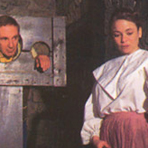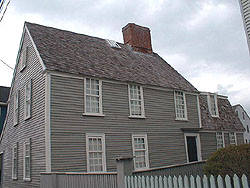 Have you read it? Have you heard about it? The Physic Book of Deliverance Dane is the first novel by Katherine Howe. The novel is about Harvard PhD student Connie Goodwin, who finds herself both working on her dissertation and preparing her grandmother's abandoned Marblehead home for potential sale during the summer of 1991.
Have you read it? Have you heard about it? The Physic Book of Deliverance Dane is the first novel by Katherine Howe. The novel is about Harvard PhD student Connie Goodwin, who finds herself both working on her dissertation and preparing her grandmother's abandoned Marblehead home for potential sale during the summer of 1991.While cleaning her "Granna's" house, Connie finds a key with a name, Deliverance Dane. And thus begins her adventure into seventeenth century Salem and Massachusetts.
You can experience Connie Goodwin's Salem, and - better yet - you can experience Deliverance Dane's Salem. Here's how to do it:
Cry Innocent - Bridget Bishop was accused of witchcraft in 1692. Participate in Cry Innocent,
 presented at Old Town Hall by the Gordon College Institute for Public History, and be a part of the jury. Hear the historical testimonies and find yourself considering the fate of Bridget Bishop just as her jury did in 1692. This case is not cut-and-dry. It is complicated. And being part of the jury just might give you a new perspective on the daily struggle of life in Salem in the late 1600s.
presented at Old Town Hall by the Gordon College Institute for Public History, and be a part of the jury. Hear the historical testimonies and find yourself considering the fate of Bridget Bishop just as her jury did in 1692. This case is not cut-and-dry. It is complicated. And being part of the jury just might give you a new perspective on the daily struggle of life in Salem in the late 1600s.The Witch House, or the Corwin House, at 310 Essex Street, is Salem's only building with direct ties to the Witch Trials of 1692. Explore the rooms where Judge Jonathon Corwin lived and determined the fate of so many people more than three hundred years ago. Stand in the kitchen and close your eyes - now imagine this is the house of Deliverance Dane, and she is sitting at the table while her daughter Mercy checks the bread in the oven.

The Old Burying Point, Charter Street Cemetery, and the Salem Witch Trials Memorial is the most appropriate place to remember the people who lost their lives during the trials of 1692. You will find the grave of, among others, "hanging judge" John Hathorne, in the Charter Street Cemetery. Behind the cemetery - and it is no accident that it is behind the cemetery - is the Witch Trials Memorial, which was dedicated in 1992.
The Memorial has a bench for each of the condemned men and women, and each bench is
 inscribed with their name, the date of their execution, and the method of execution. The memorial is intended to be stark, and the words inscribed in the entrance are fading away and have blocks falling over them - symbolizing the communities inability to hear the pleas of innocence from the accused.
inscribed with their name, the date of their execution, and the method of execution. The memorial is intended to be stark, and the words inscribed in the entrance are fading away and have blocks falling over them - symbolizing the communities inability to hear the pleas of innocence from the accused.At The Witch Dungeon Museum, 16 Lynde Street, you can watch a dramatic reenactment of one of the trials, and then you will go downstairs to tour the recreated
 dungeon. The actual dungeon was destroyed, but The Witch Dungeon Museum conveys the dank, dark, uncomfortable quarters where people were held for years. The only thing it is missing is the human smells - and I for one forgive that omission. It's best left to our imaginations.
dungeon. The actual dungeon was destroyed, but The Witch Dungeon Museum conveys the dank, dark, uncomfortable quarters where people were held for years. The only thing it is missing is the human smells - and I for one forgive that omission. It's best left to our imaginations.The Salem Witch Museum, 19 1/2 Washington Square, will start you in 1692 and bring you to present day with their two exhibits. The first presentation tells the story of 1692 and the girls' crying out that led to the trials and executions, the trials themselves, the living conditions in the jails, and the end of the Trials. The second exhibit talks about Witchcraft: Evolving Perceptions, and presents the different faces of Witchcraft and witches in different cultures and over time.

After the second exhibit at the Salem Witch Museum, you will be 2009 Salem, which is different from Connie Goodwin's 1991 Salem... we have many more shops and restaurants, the Peabody Essex Museum has been dramatically expanded, the House of the Seven Gables has invested in and restored their exhibits. We have a Ferry that connects Salem and Boston.
Don't ignore all of these fantastic aspects of Salem, but if you want to focus on the Salem of 1991 that Connie Goodwin experienced, visit Crow Haven Corner, 125 Essex Street, which was Salem's first Witch shop, to pick up a spell or have your fortune told.

If you want to visit a meeting house like the one where Connie meets Sam in the beginning of her exploration, you have a few options. Stop at Rockafellas for a bite to eat, because it is in the Old Daniel Low building, which was Salem's first meeting house and one of the first churches in America.
I suspect The First Church in Salem at 316 Essex Street would be the parish where Connie began her research. Parishioners of this church were excommunicated during the trials, and it is the oldest church in Salem. Another beautiful historic church in Salem is St. Peter's Episcopal Church at 24 St. Peter's Street. St. Peters founded after the trials, in 1733, but it was founded by Phillip English, who was accused during the 1692 Trials, and thus has an
 interesting tie to the Trials of 1692.
interesting tie to the Trials of 1692.A short walk down Essex Street from the First Church is The Salem Athenaeum, a private library in Salem that was founded in 1810. The Athenaeum received the collections of Salem's Social Library, which began in 1760.
I thought a lot about Connie's Granna's house in Marblehead, and I think it may be similar to the Narbonne House (pictured) at the Salem Maritime National Historic Site. You'll have to imagine the overgrown garden, though, as the yard around the Narbonne House is quite pristine! The Gedney House, a Historic New
 England property at 21 High Street, is another First Period home in Salem that could be similar to the house in Marblehead. Both the Narbonne House and the Gedney House are study houses, so they are not furnished, but a visit to to either will give you a sense of how a house from the 1600s looks today.
England property at 21 High Street, is another First Period home in Salem that could be similar to the house in Marblehead. Both the Narbonne House and the Gedney House are study houses, so they are not furnished, but a visit to to either will give you a sense of how a house from the 1600s looks today.Katherine Howe will be doing a reading and a book signing of The Physic Book of Deliverance Dane on July 31st at Cornerstone Books in Salem. Perhaps she will shed some light on other sites in Salem that may have inspired her novel.
No comments:
Post a Comment